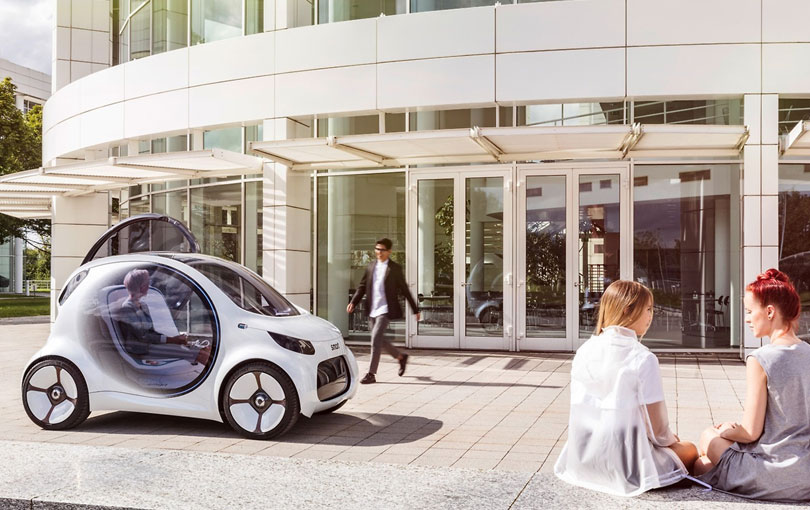

“WE’RE MAKING AUTONOMOUS DRIVING SAFE.” AN INTERVIEW ABOUT PROGRESS IN DEVELOPMENT WORK
Reading e-mails instead of contemplating bumpers — the next stage of automation will give even the daily traffic jam a new level of quality. Vehicles are being developed two generations in advance, and robot taxis will already be changing urban mobility just a few years from now. In the following interview, Dr. Michael Hafner, Head of Automated Driving and Active Safety at Mercedes-Benz, talks about sensors, safety, and the road map that developers are following.
Dr. Hafner, cars from Mercedes can already give drivers active support in dangerous situations, thanks to Intelligent Drive. Have these precursors of autonomous driving measurably improved driver safety?
Yes — substantially, in fact. Some of the precursors of autonomous driving are decades old. I’m referring specifically to anti-lock braking systems and the Electronic Stability Program (ESP), which keeps cars securely in their lanes while cornering. Accident statistics show that these systems have significantly increased safety in vehicles. When we introduced collision warning systems, it even caused sales of bumpers to drop. That’s a clear indication that the number of rear-end collisions has declined. Another milestone is automatic emergency braking. These experiences are encouraging us to work hard on the next levels of automation. We benefit from the fact that we’ve been developing and continuously enhancing the software for our systems ourselves for a long time. This is essential for a fast pace of innovation.
The next stage of automation will be the Level 3 vehicles. In these automobiles the drivers will have to stay in the driver’s seat, but they can do other things now and then. Is this intermediate step toward full automation worth the effort?
We are convinced that it is. We are currently preparing for the launch of two big innovations in parallel. For one thing, we think that highly automated driving, by which I mean Level 3, is a very promising concept. In daily life, it particularly reduces driver stress in tedious and stressful situations where there’s a lot of traffic, for example during stop-and-go traffic on highways. Level 4 and Level 5 systems will have to manage every situation — even if there’s no driver. Of course this is even more challenging from a technological standpoint. We’re working on both of these stages simultaneously.
Let’s start with Level 3. What will automated driving be like in this variant?
In this case, drivers will only give up their control of the vehicle part of the time. This variant is especially suited for the relatively uncomplicated traffic on highways. The vehicle signals to the driver when it’s ready to take over. Before it does that, it conducts a series of system checks to see if all the sensors are working and if the correct maps are being used for the vehicle’s current location. If everything is in order, the driver only needs to push a button for the vehicle to take over. Within certain limits, the driver can then do other things, such as working on e-mails via the onboard system or watching a video. However, the driver must be able to quickly take control of the steering wheel again. By “quickly” we currently mean within about five seconds. That’s why the monitoring system has to make sure that the driver doesn’t fall asleep, for example.


The Mercedes-Benz Future Truck 2025 is driving autonomously on a highway.
Are five seconds enough for drivers to effectively take charge again?
Our simulations have shown that drivers reorient themselves very well during this time and can take control of the steering wheel again. By the way, more warning time is given for the switch whenever a takeover by the driver can be planned in advance, such as when the vehicle is approaching a highway exit or a long tunnel. As a result, the switchover time will very rarely amount to only five seconds — for example, if the system encounters an unexpected situation. Needless to say, the vehicle must be able to independently respond to every imaginable situation during these five seconds. That is a precondition.
What do you tell customers who are nonetheless concerned about safety?
Safety is one of our core values. We don’t make any compromises or take any risks with respect to safety. That’s why we invest a lot of time and effort in systematically analyzing and testing every step of development. Proven safety guidelines such as ISO 26262 are very helpful in this regard. Redundant software and chip architecture are also important. All of these elements are secured by multiple backup systems, just as they are in aviation. Thanks to highly precise maps that have a completely new level of quality, we also know exactly where a vehicle is located at all times. We also know when the next curve is coming up and how sharp it is. Customers can rely on us.
Our mission is to make self-driving cars really safe. All the same, I realize that nobody will be reading a book the first time they ride in a Level 3 vehicle. Instead, everyone will first watch everything and then wait and see. But once people experience what the system can do, they’ll start to trust it.
Do you think there’s a danger that drivers will rely on the systems too much?
Of course we have to tell people exactly what the systems can and cannot do. We also have to show them where the limits are. The user interface will play a key role here.
When will the first Level 3 vehicles be ready for series production?
We’ve already made great progress in the development of a series production vehicle. In fact, we will reach this stage very soon. I wouldn’t be surprised if such a feature makes its debut in the S-Class.
Highly automated driving will be followed by fully automated and driverless driving — that is, by Levels 4 and 5. How far has Mercedes-Benz progressed with these systems?
Because we’re working on these systems in parallel, the next two stages are already well advanced. In 2017 we launched a corresponding partnership with Bosch. Our goal is to put the first driverless robot taxis on the road in the early 2020s. This will greatly increase the appeal of carsharing services and improve the flow of traffic in cities. Complex city traffic requires even more sensor technology and redundancy than we have in Level 3 vehicles on highways. But if we manage to pull this off, it will dramatically change mobility services and how they’re used.


The smart vision EQ fortwo is our vision of urban mobility in the future. It is the most radical car-sharing concept car ever: fully autonomous, communicative to the max, friendly, fully customizable and of course electric.
How is this also changing your cooperation with long-term partners such as Bosch?
Our development partnership for fully automated and driverless driving may be one of the closest in the industry at the moment. In this partnership, mixed teams work simultaneously on the same software at a jointly run location. In this way, we want to create a technology package that really contains everything a car needs in order to become a self-driving vehicle: sensors, software for sensing and “sensor fusion,” cloud-based data processing, and other components. We will offer this package to other OEMs as well.
What technological developments do you still need in order to stick to your ambitious schedule?
Many people have seen the test vehicles that are driving around with conspicuous sensor applications on their roofs. These vehicles contain much more than just a radar system. In fact, they have a wide variety of sensors on board. Their radar systems, cameras, and lidar sensors work in unison. LIDAR (Light Detection and Ranging) is also a core topic. It requires an enormous amount of computing power. We are therefore anticipating a new generation of microchips that still needs to be developed. These lidar sensors provide an additional means of measuring distances. Various models are currently under development and it’s still not clear which system will eventually come out on top, which one is stable enough for this application, and which one will pay off. That’s why we’re moving forward on several fronts here as well.
In spite of these challenges, are you optimistic about achieving your goals?
More than that. I’m convinced that autonomous driving will become part of our daily lives sooner than most people expect. For our part, we will do everything we can to make sure people feel perfectly safe in an automated or autonomously driving Mercedes.
Dr. Michael E. Hafner is the Head of Automated Driving and Active Safety at Mercedes-Benz Cars. In this capacity, he is responsible for the development of future driving functions that will lead to autonomous driving. Dr. Hafner studied electrical engineering and industrial information technology at the University of Karlsruhe. He then earned a doctorate in automation technology at Darmstadt Technical University. After joining Daimler in 2002, he held management positions for onboard diagnosis and emissions certification before becoming a Board of Management assistant for Group Research and Mercedes-Benz Cars Development (RD). From 2010 to 2013 he headed the development of E/E brake control and chassis systems, and then he took over the unit for driver assistance systems and active safety. Since October 2016 he has also been responsible for all development tasks related to fully automated driving.












